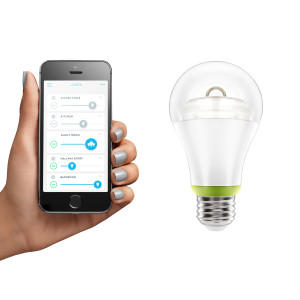Energy Efficient Lighting
By Craig DiLouie, LC

Image courtesy of GE Lighting.
In the wake of Federal regulations banning manufacture of 40-100W incandescent lamps that failed to meet new energy standards, consumers are now saving energy with three main options: energy-saving incandescent (halogen), compact fluorescent and LED. LED lamps, currently priced $5-$25, are particularly interesting because they’re so efficient, are projected to last up to 25,000 hours, and contain no mercury.
They’re also very controllable as long as the control device is specifically rated as compatible with the lamp. And as digital devices, they’re very compatible with digital control. The latest smart bulbs embed digital intelligence and a wireless receiver to offer homeowners control of their lighting that goes far beyond simple on/off (switching) and raise/lower (dimming).
Smart Bulbs Offer Complete Lighting Control
Companies such as Belkin, GE, Insteon, LIFX, Philips, Stack, TCP and others are now introducing smart lamps that offer switching, dimming and color tuning. These effects may occur based on time of day or whether somebody is in the room. The homeowner can adjust settings using one or more mobile apps. All communication takes place over a wireless network in which each smart bulb has its own unique address, creating a home-based lighting network.
These lamps offer total lighting control. Features vary by product, with the range of capabilities including:
- A-lamp versions producing light output comparable with a 60W incandescent, with other lamp options available such as floods.
- Long life of 10,000 to 20,000+ hours.
- Both manual and automatic switching, dimming and color tuning.
- Color tuning across a vast palette of colors, including a selection of basic warm to neutral to cool shades of white light.
- Scene (specific lighting scheme based on lamps being on, dim level and color setting) memory and recall.
- Response to user commands (via a mobile app), programmable schedule (including pre-programmed options) and onboard sensors that detect light levels and occupancy and automatically turn off or dim the lights to save energy.
Additionally, the system may offer special features such as:
- Automatic adjustment of color shade of white light based on time of day.
- Wakeup mode that ramps up the lights in the morning with a cooler or neutral white hue to promote alertness.
- Sleep mode that causes lights to slowly dim at night with a warm hue.
- Interaction with other home electronics such as TVs, music, security and thermostats.
- Porch and other selected home lights activate at certain time of day when you’re expected home from work or in response to actual proximity (via GPS), and turn off after you’ve left the area.
- “Away” mode that deters home intrusion by randomly turning lights on and off to make the home appear occupied.
- Lights synchronize with music to create a light show.
- Lights come on to ward off intruders and provide additional alert in case of fire.
- Lights signal there’s an incoming call on the phone.
Quick and Easy Smart Bulb Set Up
The system may use a wireless hub that can control a maximum number of lamps, typically 50 but up to 64 depending on the product, or enable the mobile device to talk to the lighting network directly. The system is typically fairly easy to set up—replace the existing lamps, set up the hub and download/install the app—but actual use may be complicated for some users. The wall or luminaire switch must remain on for the lamp to produce programmed effects such as wakeup mode, meaning the lamp must be turned off using the app, which may be cumbersome for some users. Some products supplement the use of an app with a handheld remote. The bulbs are also pricier than typical LED lamps (with the added cost of the hub and remotes if desired), though costs have been coming down as the technology develops and new competitors enter the market.
Besides smart bulbs, other approaches are available, such as hardwired and wireless home and lighting automation systems.
In the wake of the Energy Independence and Security Act, home lighting is not only getting energy-efficient, it’s getting smarter, offering users control possibilities that a decade ago seemed the stuff of science fiction.
What You Need To Know About Smart Bulbs:
- LED lamp adoption is growing
- High end of LED lamp is smart bulbs
- Smart bulbs communicate wirelessly to create a lighting network that is programmable and controllable using a mobile app
- Users can control switching, dimming and color
- Onboard sensors dim or switch the lights to save energy
- Wide range of special features and application